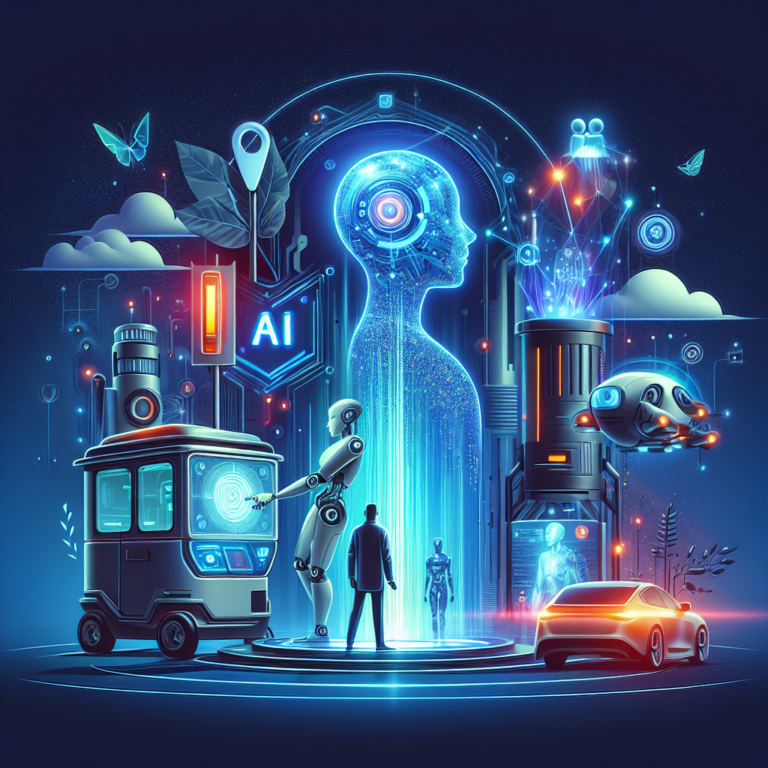
In today’s rapidly evolving business landscape, leveraging artificial intelligence (AI) has become essential for organizations aiming to stay at the forefront of innovation. AI has proven to be a powerful tool in developing new products and services, enabling businesses to streamline processes, gain valuable insights, and unlock creative possibilities. By harnessing AI technology, companies can unlock new realms of potential, revolutionizing their industries and setting the stage for future success. Discover how to navigate this exciting terrain and harness the power of AI to drive your organization’s growth and development.

Understanding AI
Artificial Intelligence (AI) is an innovative technology that enables machines to perform tasks that would typically require human intelligence. By simulating human cognition and learning capabilities, AI has the potential to revolutionize various industries and enhance the efficiency and effectiveness of product development.
What is AI?
AI encompasses a broad range of technologies, algorithms, and systems designed to mimic human intelligence. These systems can analyze vast amounts of data, recognize patterns, make predictions, and adapt to changing circumstances. AI can manifest in various forms, including machine learning, natural language processing, computer vision, and robotics.
Different types of AI
There are several types of AI, each with its specific capabilities and applications. Rule-based AI (also known as expert systems) relies on predefined rules and logic to process information and make decisions. Machine learning algorithms enable systems to learn and improve from data without explicit programming. Deep learning algorithms, inspired by the human brain’s neural networks, excel at recognizing complex patterns and solving intricate problems. Reinforcement learning involves training systems through an iterative trial-and-error process to maximize desired outcomes.
Benefits of using AI in product development
Integrating AI into product development processes can yield numerous benefits. Firstly, AI can automate routine tasks, freeing up human resources to focus on higher-value activities. Additionally, AI algorithms can analyze large datasets rapidly, uncovering valuable insights that humans might miss. This helps inform decision-making and leads to more informed and data-driven product development strategies. AI-powered personalization and recommendations can enhance the customer experience by tailoring products and services to individuals’ preferences. Finally, AI can optimize operations and increase efficiency, thus reducing costs and enhancing overall productivity.
Identifying Opportunities for AI
Before implementing AI in product development, it is crucial to identify the areas where AI can bring value and make a significant impact. The following steps will help you identify and evaluate the potential opportunities for AI implementation.
Evaluating existing products and services
Start by evaluating your existing products and services to identify pain points, inefficiencies, and areas that could benefit from AI-driven enhancements. Look for areas where automation, data analysis, or predictive capabilities could improve performance and customer satisfaction. Consider customer feedback, user behavior data, and feedback from internal stakeholders to gain insights into potential areas of improvement.
Identifying areas where AI can be applied
Once you have evaluated your existing products and services, conduct a thorough analysis of various business processes to identify potential areas where AI can be applied. Look for tasks that are repetitive, time-consuming, or require complex decision-making that can be automated or enhanced with AI. For example, customer support, sales forecasting, inventory management, and fraud detection are all areas where AI can bring significant value.
Setting specific goals and objectives
Define clear and specific goals and objectives for implementing AI in your product development process. Identify the desired outcomes you aim to achieve with AI integration, such as improved efficiency, enhanced customer experience, or increased revenue. Setting measurable objectives will help guide your AI implementation strategy and enable you to track progress and measure success.
Collecting and Analyzing Data
Data is the fuel that powers AI systems. Collecting, analyzing, and interpreting the right data is crucial for successful AI implementation. Follow these steps to ensure you gather high-quality data for your AI models.
Types of data to collect
Identify the types of data that are relevant to your product development goals. This could include customer demographic information, user behavior data, historical sales data, social media sentiment, or any other data that can provide insights into your target audience and market trends. Diverse and comprehensive datasets will allow your AI models to train and make accurate predictions.
Methods for data collection
Choose the most suitable methods for collecting the required data. This can involve leveraging existing data sources within your organization, such as CRM systems, transactional databases, or web analytics tools. Additionally, consider external sources such as open data repositories, social media APIs, or third-party data providers. Data collection methods can also include surveys, interviews, or user testing to gather specific information directly from customers.
Analyzing and interpreting data
Once you have collected the data, it is essential to analyze and interpret it to extract meaningful insights. This typically involves using statistical techniques, data visualization tools, and AI algorithms to uncover patterns, correlations, and trends within the data. The insights gained from data analysis will guide your decision-making process and provide valuable input to design and develop AI models.
Building AI Models
Building AI models is a critical step in leveraging AI for product development. This involves selecting the right algorithms, training and fine-tuning the models, and validating and refining them for optimal performance.
Choosing the right algorithms
Selecting the appropriate algorithms depends on the specific problem you are trying to solve and the type of data you have. Machine learning algorithms, such as decision trees, neural networks, or support vector machines, are commonly used for tasks such as classification, regression, or clustering. Deep learning algorithms, such as convolutional neural networks, excel at image recognition and natural language processing. Reinforcement learning algorithms are suitable when training systems to make sequential decisions in dynamic environments.
Training and fine-tuning the model
Training AI models involves feeding them with labeled data and allowing them to learn from it. This process entails adjusting the model’s parameters iteratively to minimize errors and increase accuracy. Fine-tuning the models involves optimizing performance by adjusting hyperparameters, exploring different model architectures, or applying regularization techniques. Training and fine-tuning may require significant computational resources and iterations to achieve satisfactory results.
Validating and refining the model
After training the model, it is crucial to validate its performance using independent datasets that were not used for training. This helps ensure that the model’s performance is not biased or overfit to the training data. Additionally, consider conducting A/B testing or user studies to evaluate the model’s performance in real-world scenarios. Based on the validation results, refine the model by making necessary adjustments and retraining if necessary.

Implementing AI in the Development Process
Integrating AI into the product development process involves utilizing it strategically at different stages to enhance various aspects of the development lifecycle.
Integrating AI in the design phase
During the design phase, leverage AI to gain valuable insights into customer preferences, market trends, and potential design improvements. AI can analyze user feedback, social media sentiment, and consumption patterns to help inform design decisions and identify features that will resonate with users. By applying AI-powered design tools, designers can automate tasks like generating design variations, optimizing layouts, or conducting usability tests.
Leveraging AI for prototyping and testing
AI can play a crucial role in prototyping and testing by automating repetitive tasks and accelerating the iterative process. Use AI to generate prototypes or simulation models, thereby reducing manual effort and improving efficiency. Moreover, AI algorithms can analyze user feedback from early prototypes, providing insights for further refinement. AI-powered testing frameworks can also automate test case generation, identify potential vulnerabilities, and optimize test coverage.
Iterative development with AI
AI enables iterative development by continuously analyzing user feedback, monitoring performance metrics, and suggesting improvements. Use AI to gather and analyze user feedback through techniques like sentiment analysis or user behavior tracking. This data can drive iterative decision-making, helping refine the product throughout its development lifecycle. Incorporating AI in agile development methodologies can facilitate faster adaptation to user needs and streamline the development process.
Enhancing Customer Experience with AI
AI offers several opportunities to enhance the customer experience through personalized interactions, intelligent recommendations, and efficient support systems.
Personalization and recommendation engines
AI-powered personalization enables tailoring products and services to meet individuals’ specific needs and preferences. Personalization algorithms leverage user data, transaction history, and behavioral patterns to recommend relevant products, content, or services. By understanding individual preferences, AI can create unique user experiences that increase customer satisfaction and drive customer loyalty.
Virtual assistants and chatbots
Virtual assistants and chatbots leverage natural language processing and machine learning to interact with customers autonomously. They can provide instant answers to customer inquiries, assist with product selection, or resolve common issues. Virtual assistants and chatbots enable round-the-clock customer support, reducing response times and ensuring a seamless customer experience.
AI-powered customer support
AI can automate various customer support activities, such as ticket routing, case classification, or sentiment analysis. By automating routine tasks, AI enables customer support teams to focus more on complex inquiries and improve response times. AI-powered chatbots and virtual assistants can also handle customer support queries, escalating to human agents when necessary. This improves operational efficiency while ensuring customers receive timely and accurate support.
Optimizing Operations and Efficiency
AI can optimize operational processes, automate routine tasks, and enable predictive capabilities, leading to increased efficiency and cost savings.
Automating routine tasks with AI
AI can automate repetitive and mundane tasks, such as data entry, document processing, or inventory management. By reducing manual effort, organizations can allocate resources to more value-added activities. AI-powered robotic process automation (RPA) can mimic human actions in digital systems by automating rule-based processes. This reduces errors, increases productivity, and allows employees to focus on higher-level tasks.
Predictive maintenance and fault detection
AI can enable predictive maintenance by analyzing sensor data, historical maintenance records, and real-time operational data. Predictive algorithms can identify patterns and anomalies, predicting when equipment is likely to fail or require maintenance. By adopting proactive maintenance strategies, organizations can minimize downtime, optimize maintenance schedules, and reduce maintenance costs.
Optimizing supply chain with AI
AI can enhance supply chain operations by optimizing demand forecasting, inventory management, and logistics. Machine learning algorithms can analyze historical sales data, market trends, and external factors to forecast demand accurately. This enables organizations to optimize inventory levels, reduce stockouts, and improve supply chain efficiency. AI can also assist in route optimization, reducing transportation costs and delivery times.
Addressing Ethical Considerations
When implementing AI, it is crucial to address ethical considerations to ensure fairness, transparency, and respect for user data and privacy.
Ensuring fairness and transparency
AI algorithms should be designed and trained to avoid biases and ensure fair treatment of all individuals. It is important to regularly assess AI models for potential biases and take necessary corrective actions. Transparent decision-making processes and explanations for AI-powered outcomes are essential to gain user trust and enable accountability.
Mitigating bias in algorithms
Bias can be inadvertently introduced into AI models due to biased training data or flawed algorithms. Regularly audit and analyze AI models to identify and mitigate biases. The use of diverse and representative datasets during model training can minimize bias. Collaboration with domain experts and diverse teams can bring different perspectives and help recognize and mitigate bias effectively.
Protecting user data and privacy
Respecting user data privacy and ensuring data security are paramount when implementing AI. Comply with relevant data protection regulations, obtain necessary user consent, and implement robust security measures to safeguard user data. AI systems should be designed with privacy in mind, ensuring that personal data is anonymized and processed securely.
Monitoring and Improving AI Systems
AI systems require continuous monitoring, evaluation, and improvement to maintain optimum performance and address changing requirements.
Continuous monitoring and performance evaluation
Regularly monitor and evaluate AI system performance to ensure alignment with business objectives and user expectations. Establish performance metrics and monitor key performance indicators (KPIs) to detect deviations or potential issues. Conduct regular audits and analyze feedback from users and stakeholders to identify areas for improvement.
Updating and retraining models
AI models can become suboptimal over time due to changing data patterns or evolving user needs. Regularly update and retrain AI models to ensure their continued accuracy and relevance. Monitor data quality, assess the need for additional training data, and adapt models to evolving contexts to improve their performance and reliability.
Feedback loop for improvement
Create a feedback loop between AI systems and human operators to enable continuous improvement. Encourage users, employees, and stakeholders to provide feedback on AI system performance, usability, and effectiveness. Use this feedback to identify opportunities for enhancement and implement iterative improvements. This feedback loop fosters a user-centric approach and drives continuous innovation.
Collaborating with AI Experts
Building a strong AI team and fostering collaborations with AI experts can significantly accelerate the development and implementation of AI-powered products and services.
Building a team of AI experts
Assembling a team with the right AI expertise is critical for successful implementation. Recruit individuals with skills in data science, machine learning, software engineering, and domain-specific knowledge. A multidisciplinary team with diverse perspectives and expertise will drive innovation and ensure comprehensive coverage of AI-related tasks and challenges.
Partnering with AI startups and vendors
Collaborating with AI startups or established AI vendors can provide access to cutting-edge technologies, expertise, and resources. Startups often have innovative approaches and agility, while established vendors can offer scalable solutions and support. Evaluate partnerships based on shared goals, compatibility, and proven track records to ensure a mutually beneficial collaboration.
Fostering a culture of innovation
Create an organizational culture that embraces innovation and experimentation. Encourage curiosity, collaboration, and a growth mindset to foster an environment that supports AI development. Provide opportunities for continuous learning, facilitate knowledge sharing, and recognize and reward innovative ideas and initiatives. By creating a culture of innovation, organizations can unlock the full potential of AI and encourage ongoing advancements.
In conclusion, AI presents immense opportunities for developing new products and services. By understanding AI, identifying relevant opportunities, collecting and analyzing data, building AI models, implementing AI strategically, enhancing the customer experience, optimizing operations, addressing ethical considerations, monitoring and improving systems, and collaborating with AI experts, organizations can harness the potential of AI to drive innovation, efficiency, and transformative change. Embracing AI as a tool for product development enables businesses to stay competitive, deliver exceptional customer experiences, and pave the way for a future where intelligent automation and human ingenuity coexist harmoniously.






